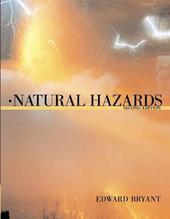
|
Natural Hazards
Paperback / softback
Main Details
| Title |
Natural Hazards
|
| Authors and Contributors |
By (author) Edward Bryant
|
| Physical Properties |
| Format:Paperback / softback | | Pages:330 | | Dimensions(mm): Height 279,Width 216 |
|
| Category/Genre | Environmental science, engineering and technology |
|---|
| ISBN/Barcode |
9780521537438
|
| Classifications | Dewey:363.34 |
|---|
| Audience | | Tertiary Education (US: College) | | Professional & Vocational | | General | |
|---|
| Edition |
Updated edition
|
| Illustrations |
80 Halftones, unspecified; 100 Line drawings, unspecified
|
|
Publishing Details |
| Publisher |
Cambridge University Press
|
| Imprint |
Cambridge University Press
|
| Publication Date |
16 November 2004 |
| Publication Country |
United Kingdom
|
Description
Natural hazards afflict all corners of the Earth; often unexpected, seemingly unavoidable and frequently catastrophic in their impact. This revised edition is a comprehensive, inter-disciplinary treatment of the full range of natural hazards. Accessible, readable and well supported by over 180 maps, diagrams and photographs, it is a standard text for students and an invaluable guide for professionals in the field. Clearly and concisely, the author describes and explains how hazards occur, examines prediction methods, considers recent and historical hazard events and explores the social impact of such disasters. This revised edition makes good use of the wealth of recent research into climate change and its effects.
Author Biography
Edward Bryant is Associate Dean of Science at Wollongong University in Australia. Among his other publications is Tsunami: The Underrated Hazard (Cambridge University Press, 2001). He has particular interest in climatic change and coastal evolution.
Reviews'Professor Bryant's heroic compilation is an excellent guide.' Scientific American 'The author writes a very readable work that is easily understood by students, professionals, and lay readers with interest in the field of natural disaster risk reduction ... Natural Hazards is a valuable contribution of the UN International Strategy for Disaster Reduction. It will appeal to students, scientists, and disaster risk managers. It will also appeal to the general public interested in natural hazards.' EOS
|